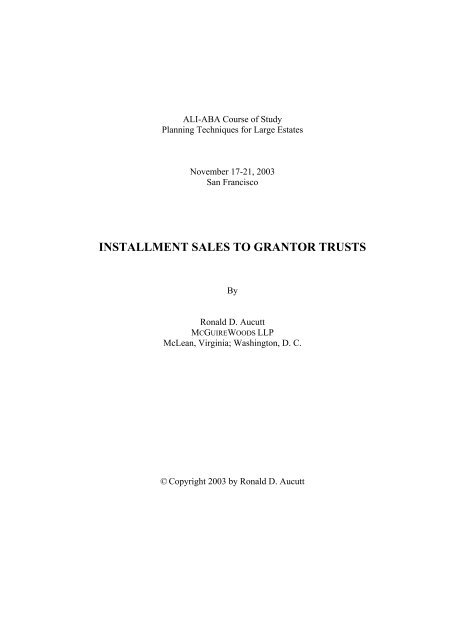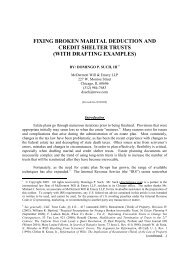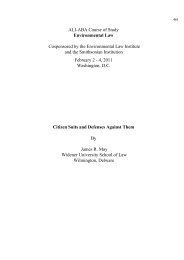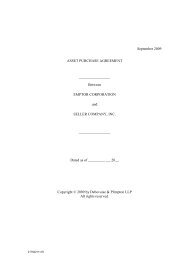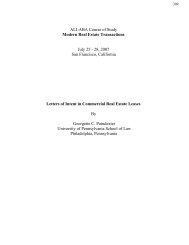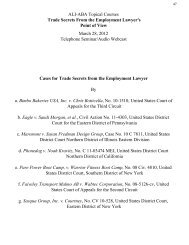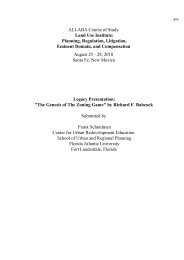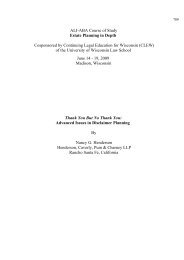INSTALLMENT SALES TO GRANTOR TRUSTS
INSTALLMENT SALES TO GRANTOR TRUSTS
INSTALLMENT SALES TO GRANTOR TRUSTS
You also want an ePaper? Increase the reach of your titles
YUMPU automatically turns print PDFs into web optimized ePapers that Google loves.
ALI-ABA Course of Study<br />
Planning Techniques for Large Estates<br />
November 17-21, 2003<br />
San Francisco<br />
<strong>INSTALLMENT</strong> <strong>SALES</strong> <strong>TO</strong> GRAN<strong>TO</strong>R <strong>TRUSTS</strong><br />
By<br />
Ronald D. Aucutt<br />
MCGUIREWOODS LLP<br />
McLean, Virginia; Washington, D. C.<br />
© Copyright 2003 by Ronald D. Aucutt
<strong>INSTALLMENT</strong> <strong>SALES</strong> <strong>TO</strong> GRAN<strong>TO</strong>R <strong>TRUSTS</strong><br />
Ronald D. Aucutt<br />
November 20, 2003<br />
Table of Contents<br />
I. Introduction...........................................................................................................1<br />
II. Basic Concepts......................................................................................................1<br />
III. Fundamental Authorities.......................................................................................3<br />
IV. Structuring the Trust .............................................................................................5<br />
V. Ensuring Grantor Trust Treatment........................................................................6<br />
VI. Structuring the Sale.............................................................................................16<br />
VII. Comparing Installment Sales with Other Techniques ........................................28<br />
VIII. Advanced Applications.......................................................................................33<br />
IX. Tax Consequences at the Grantor’s Death..........................................................34<br />
X. The Future of the Briar Patch..............................................................................36<br />
XI. Appendix A, Rev. Rul. 85-13, 1985-1 C.B. 184.................................................37<br />
XII. Appendix B, Letter Ruling 9535026...................................................................40<br />
[Page numbers refer to numbers at the bottom of the page.]
<strong>INSTALLMENT</strong> <strong>SALES</strong> <strong>TO</strong> GRAN<strong>TO</strong>R <strong>TRUSTS</strong><br />
Ronald D. Aucutt<br />
I. Introduction<br />
An installment sale to a grantor trust can be useful in transmitting wealth in a<br />
tax-efficient way, and often it is superior to other methods. It is in effect an estate<br />
freeze technique that capitalizes on the lack of symmetry between the income tax<br />
rules governing grantor trusts and the estate tax rules governing includibility in the<br />
gross estate. Like most techniques, it can be used conservatively, aggressively, or<br />
even recklessly, and some of the tax consequences are unclear. Moreover, like most<br />
techniques, its availability and usefulness must be evaluated on a case-by-case basis,<br />
with a view to the circumstances, and especially the arithmetic, in each case.<br />
II.<br />
Basic Concepts<br />
A. The concept of estate freezing.<br />
1. A gift is a freeze.<br />
a. Future appreciation escapes gift or estate tax. Thus, the best subject of a<br />
gift is a “hot asset” that will appreciate greatly over its fair market value<br />
today. [Clients usually know what these hot assets are. Lawyers don’t.]<br />
b. Any gift tax paid also escapes tax, if the donor survives three years.<br />
Section 2035(b).<br />
c. An outright gift should be used as the baseline for all other freeze<br />
techniques. If a technique does not outperform an outright gift, the estate<br />
planner should carefully review the tax and non-tax reasons for<br />
recommending it.<br />
2. A sale is a freeze.<br />
a. The reasons are similar. The future appreciation escapes gift or estate tax,<br />
while the purchase price is generally frozen.<br />
b. An installment sale is simply a way to assist the buyer to make the<br />
purchase by allowing the purchase price to be paid in whole or in part out<br />
of the earnings of the purchased asset (but not in such a way as to create in<br />
the seller a retained interest in the sold asset that is subject to the rules of<br />
section 2701, 2036, or 2038). In some cases, an installment sale also<br />
- 1 -
enables the seller to spread the taxable capital gain over several taxable<br />
periods (not applicable here).<br />
c. Thus, cash can be the subject of an installment sale. That is called a<br />
“loan.” If the borrower invests the cash in something that produces a lot<br />
of income or appreciation, that is also a type of freeze—the income and<br />
appreciation accrue in the buyer’s estate, not the seller’s. A loan is an<br />
effective estate planning to the extent the borrower is able to use the loan<br />
proceeds to produce income or appreciation at a rate greater than the<br />
interest rate on the loan. But “sales” of cash are really not very<br />
interesting.<br />
B. The concept of leveraging, or freezing off a discount.<br />
1. If what is given—or sold—has a value that is legitimately discounted, then the<br />
freeze shelters from future gift and estate tax not only the future appreciation in<br />
the intrinsic or ultimate value to the donee or buyer, but also (without regard to<br />
such future appreciation) the “appreciation” represented by the discount—that<br />
is, the difference between that intrinsic value and fair market value, the standard<br />
for estate and gift tax purposes.<br />
2. See Reg. §§ 20.2031-1(b) & 25.2512-1; United States v. Cartwright, 411 U.S.<br />
546, 551 (1973); Propstra v. United States, 680 F.2d 1248, 1252 (9th Cir.<br />
1982); Estate of Andrews v. Commissioner, 79 T.C. 938, 952-53 (1982); Estate<br />
of Mellinger v. Commissioner, 112 T.C. No. 4 (Jan. 27, 1999), acq., AOD 99-<br />
006, 1999-35 I.R.B. 314; Rev. Rul. 93-12, 1993-1 C.B. 202.<br />
C. The use of a grantor trust as the buyer.<br />
1. For this purpose, a grantor trust is a trust as to all of which the grantor is treated<br />
as the owner under section 671 (and the grantor is the seller)<br />
2. Obvious advantages of using a grantor trust.<br />
a. No capital gain is realized on the sale. Rev. Rul. 85-13, 1985-1 C.B. 184.<br />
b. Since there is no tax, there is no concern about the additional interest<br />
under section 453A on deferred tax liability in excess of $5,000,000.<br />
c. No income is realized when the trust pays interest on the installment<br />
obligation to the grantor.<br />
d. No gain is realized if property is transferred to the grantor in kind in<br />
payment of any part of the installment obligation.<br />
e. The trust may be a shareholder of an S corporation, under section<br />
1361(c)(2)(A)(i).<br />
- 2 -
f. The grantor, not the trust or the beneficiaries, will pay all the income taxes<br />
on income attributable to the trust.<br />
g. If a residence is held by a grantor trust, the grantor-beneficiary will be<br />
treated as the owner of the residence and the exclusion rules of section 121<br />
will apply. Reg § 1.121-1(c)(3)(i).<br />
III. Fundamental Authorities<br />
A. Rev. Rul. 85-13, 1985-1 C.B. 184 [See Appendix A on page 37].<br />
1. Bottom line: For income tax purposes, a grantor trust is disregarded. There can<br />
be no transactions between a grantor and the trust. The trust is simply a pocket<br />
of the grantor.<br />
2. Rev. Rul. 85-13 essentially involved a grantor’s 1981 installment purchase (for<br />
a note) of closely-held stock from a Clifford-type trust. The income beneficiary<br />
of the trust was the grantor’s son for 15 years, which, prior to the replacement of<br />
the ten-year standard by a 5-percent standard in section 673, did not render the<br />
trust a grantor trust. Neither was there any other feature of the trust that would<br />
render it a grantor trust.<br />
a. Nevertheless, the Service treated the trust as a grantor trust, because the<br />
installment purchase was the economic equivalent of the grantor’s<br />
purchase of the trust’s property for cash followed by the grantor’s<br />
borrowing the cash from the trust in exchange for the note, and the<br />
grantor’s borrowing from the trust, until repayment, rendered it a grantor<br />
trust under section 675(3).<br />
b. Since the trust was a grantor trust, the grantor was treated as the owner of<br />
the trust and therefore the owner of the note. Therefore, the transaction<br />
could not be a sale, because the grantor was both the maker and owner of<br />
the note, and a transaction cannot be a sale if the same person is treated as<br />
owning the purported consideration both before and after the transaction.<br />
c. Since the transaction was not a sale, the grantor did not obtain a new cost<br />
basis in the stock.<br />
3. The Service acknowledged that Rothstein v. United States, 735 F.2d 704 (2d<br />
Cir. 1984), had reached the opposite result on essentially identical facts, but the<br />
Service announced that it would not follow Rothstein (without even an<br />
exception for the Second Circuit).<br />
4. The Service has consistently cited Rev. Rul. 85-13 for the proposition that a<br />
grantor and a grantor trust cannot have transactions with income tax<br />
significance, most recently in Letter Ruling 200247006 (August 9, 2002)<br />
(transfer for consideration of a life insurance policy from a grantor trust to<br />
- 3 -


